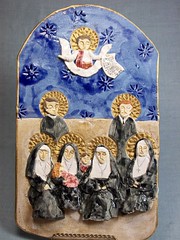Here, finally, is the 90% completed icon for the Martyrs of Memphis that will go home this weekend with the Sisters of St. Mary's in Sewanee, TN. I finished the gold portions today*, ironically, on the feast day of Constance and her companions.
I've shown you pictures of this and my other version of the Martyrs icon before, but I'm not sure I've explained why I'm so fascinated with this group of mostly women (but including men) featured here.
I attend St. Mary's Episcopal Cathedral**, located at the fringes of downtown Memphis, TN. It is in the medical district (appropriately, given its history with the Yellow Fever Epidemic, when over 5,000 Memphians died), bridging bustling downtown, impoverished neighborhoods, three hospitals, and numerous social-service organizations, including several missions for the homeless. During the 1978 Yellow Fever Epidemic, St. Mary's (a mission church of the larger downtown Episcopal church, billed as a "house of prayer for all people" because its parishoners weren't required to buy their pews, attracting members of lower socio-economic status) opened its doors to those orphaned by the fever. The Sisters, led by Constance, ran a school for girls. When the epidemic struck, Constance and Thecla were safely on vacation but returned to nurse the poor (for everyone of means left the city posthaste), sick, and dying. They worked until they, too, were struck with the fever. Charles Parsons was rector of Grace Church in Memphis and served with the sisters. Louis Schuyler came to Memphis from Hoboken, NJ, to serve at St. Mary's and died 10 days after he arrived.
Sunday night I finished Molly Crosby's excellent American Plague, a history of the Yellow Fever, it's multiple epidemics, and the scientists who worked to discover its roots and develop a vaccine. The story was mind-boggling. The sacrifices of the priests, nuns, doctors, and scientists were nothing short of enormous. At the top of the icon, an angel holds a scroll with the verse from John 15:13 "no man has greater love than this, than to lay down his life for his friends."
* I had completely forgotten what the actual date of the Martyrs feast was until I was contacted by Fr. Miguel Zavala Mugica, who requested permission to use the image of one of the icons for his excellent (but written in spanish) blog.
**St. Mary's also played an active role in the 1968 Sanitation Workers' strike and the Civil Rights Movement in Memphis. Dean William Dimmick carried the cathedral's processional cross in an inter-faith march to city hall the day after the Rev. Martin Luther King, Jr. was slain. It split the church, but many of those who stayed were dedicated to social justice issues, specifically involving the sick, the poor, and the homeless.

3 comments:
what an amazing yet sad story. a lot of history there. your piece is so beautiful. great that it can be shared and admired.
Dear Melissa,
I am serving on a Episcopal Cursillo weekend in November on Long Island. I am head of a table of men and women on the retreat. Each table takes the name of a different saint, and your post about St. Constance inspired me to tell her story and use her name as our "mascot." I'd forgotten it, but had read it many years ago.
Would you mind if I used your icon on a bookmark that I will pass out to the people at my table, with a little of the history about the martyrs? I would certainly credit your artwork. The icon is so beautiful.
If you wouldn't mind if I used it, could you send me a photo that I could scan or copy for the bookmark?
Thanks so much! I'm still loving my berry bowl!
Wylie
Beautiful piece Melissa. Heartbreaking what the city went through then. I've been meaning to read the book, I keep seeing it in Davis-Kidd.
Post a Comment